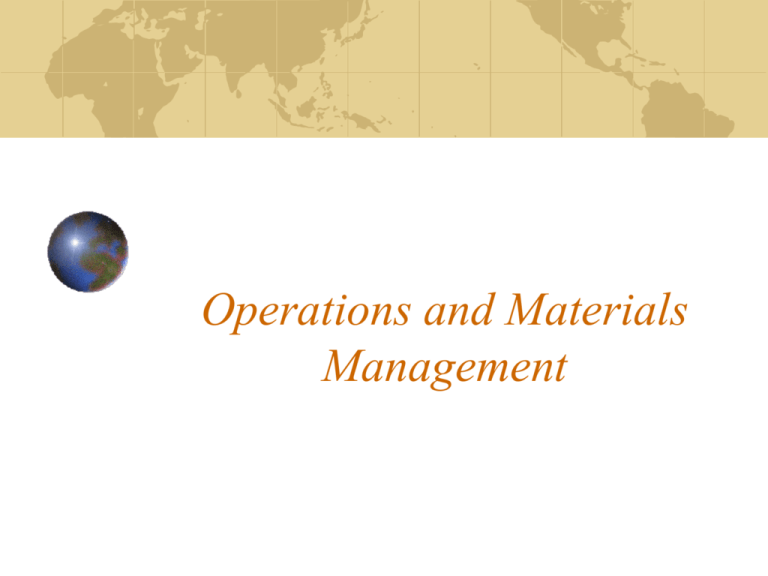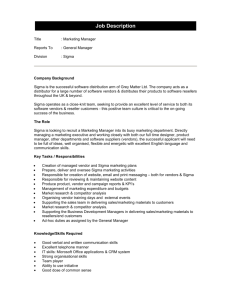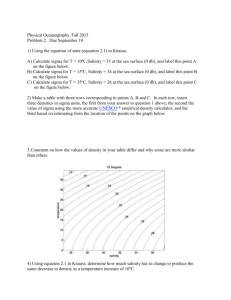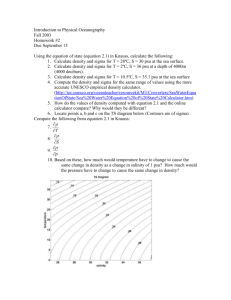Strategic Planning
advertisement

Operations and Materials Management What We Will Discuss: Competitive Advantage Value Chain Overview Competitive Advantage Requires a Focus on: Productivity Quality Innovation Customer Responsiveness Productivity More effective use of resources Lower inventory holding costs Reduced time to process customer orders Innovation Find ways to improve product quality Find ways to reduce production costs Find ways to sell products at a lower cost Responsiveness to Customers High quality customer service Satisfying shopping experience Good after-sales service Increase Quality Number of customer orders correctly processed Consistent, reliable products Ensure supply of high quality inputs Two types of quality and their relationship to costs Quality of performance Quality of conformance How? Approaches to Gain Competitive Advantage Increasing emphasis on balancing financial side and human/creative/socially responsible side of organizational strategy Different metrics to evaluate success than in the past Examples: Six Sigma Balanced Scorecard Blue Ocean Strategy Six Sigma What is Six Sigma? According to iSixSigma (www.isixsigma.com), Six Sigma is: a measure of quality that strives for near perfection a data-driven, quantitative approach and methodology for eliminating defects in any process: manufacturing, transactions, products, & services Six Sigma (cont’d.) A successful Six Sigma process produces no more than 3.4 defects per million opportunities A defect is defined as anything outside of customer specifications Six Sigma processes are executed by Six Sigma “Green Belts” (team leaders who implement process improvement projects) & “Black Belts” (successful project leaders who are credentialed through an exam and are skilled in the use of Six Sigma methodology & tools) The Balanced Scorecard (Kaplan & Norton) A strategic management system that drives performance and accountability throughout the organization Balances traditional performance measures with forward-looking indicators in four “perspectives”. The Balanced Scorecard’s Four Perspectives 1. Financial perspective Among the four perspectives, organizations generally place the greatest emphasis on financials Financial results ultimately are the primary driver of a firm’s decisions 2. Customer perspective Customer focus, customer satisfaction Customers need to be happy. If customers aren’t happy, they’ll go to other suppliers 3. Business perspective How well the business is running Do products, services conform to customer requirements? Ex: downloading music - major record labels resisted change by arresting casual music downloaders vs. partnering with Napster, Amazon, etc. to create new distribution models 4. Learning and growth perspective Employee training Corporate cultural attitudes toward self-improvement Knowledge environment: people are a firm’s most important resource Metrics: You can’t improve what you can’t measure Environment of uncertainty, ambiguity and change: workers must continually learn Mentors Tutors Communication & sharing info: break out of functional silos Blue Ocean Strategy (Kim & Mauborgne) Demand is created through innovation, not fought over Concept of developing new, uncontested market space, rather than competing in existing markets Ample growth that is rapid & profitable Not based on stealing customers in existing market Makes competition irrelevant. Ex: Curves Fitness Centers vs. Bally’s • A Curves customer will never consider joining Bally’s • Represents a different demographic - women, older, not “skinny”. • How does Curves meet the needs of its demographic? Fitness equipment faces inward to encourage conversation & encouragement, rather than individuals facing mirrors & using iPods Cirque de Soleil (circus for adults, not kids; expensive, Las Vegas environment, etc.) Southwest Airlines, Virgin Airways (fun, low cost, customer gets involved) Blue Ocean vs. Red Ocean Strategy The Red Ocean Strategy: Competes in an existing market Focuses on “beating the competition” Exploits existing demand Aligns the firm’s activities with a strategic choice of either differentiation or low cost. Vs… The Blue Ocean Strategy: Creates uncontested market space by making competition irrelevant Creates and captures new demand Aligns the firm’s activities with strategic choice of both differentiation and low cost Requires constant innovation; big picture thinking; new type of strategic leaders across organization The Value Chain







